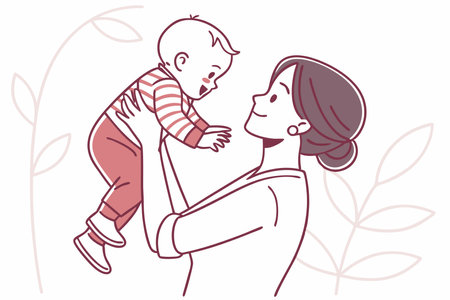1. The Role of the Brain in Language Development
From the moment a baby is born, their brain begins an incredible journey of learning and development. One of the most fascinating aspects of this journey is how babies acquire language. Understanding the science behind early language development can help parents create an environment that nurtures their childs communication skills.
How a Babys Brain Processes Language
A babys brain is like a sponge, rapidly absorbing information from its surroundings. The brain has specialized areas responsible for processing language, primarily the Broca’s area, which controls speech production, and the Wernicke’s area, which helps with understanding words. These regions work together to help babies recognize sounds, form associations, and eventually start speaking.
The Importance of Neural Connections
During early childhood, the brain forms millions of neural connections every second. These connections are strengthened through exposure to language. When parents talk, sing, or read to their baby, they stimulate these neural pathways, reinforcing language development.
Key Factors That Strengthen Neural Connections
| Factor | Description |
|---|---|
| Talking to Your Baby | Engaging in conversations, even if your baby cant respond yet, helps build language skills. |
| Reading Aloud | Introducing books early helps babies associate words with meaning and rhythm. |
| Singing Songs | Music introduces patterns and repetition, making it easier for babies to remember words. |
| Interactive Play | Pretend play and games encourage babies to respond using sounds and gestures. |
The Role of Early Stimulation
The more a baby is exposed to language in their early months and years, the stronger their language skills will be as they grow. This doesn’t mean drilling vocabulary but rather engaging in natural interactions—talking during daily activities like feeding, dressing, or playing. The more varied and rich the language input, the better their brain can process and learn.
Why Early Stimulation Matters
The first few years are critical because the brain is highly adaptable. If a baby doesn’t receive enough verbal interaction during this period, their ability to develop strong language skills may be impacted later on. That’s why talking to your baby from birth is so essential—it lays the foundation for future communication skills.
2. The Critical Period for Language Learning
Babies go through a unique phase in their early years when their brains are especially receptive to language. This is known as the critical period for language learning. During this time, their brains are like sponges, absorbing sounds, words, and sentence structures from their environment at an incredible rate.
What Is the Critical Period?
The critical period refers to the window of time when babies and young children are most capable of acquiring language naturally. Research suggests that this period starts at birth and gradually declines after early childhood. While it’s still possible to learn new languages later in life, it becomes more challenging as the brain loses some of its natural flexibility.
Why Is Early Language Exposure Important?
Exposing babies to rich language experiences during this sensitive window helps them develop strong communication skills that last a lifetime. The more they hear and interact with language, the better they become at understanding and using it.
Key Benefits of Early Language Exposure
| Benefit | Impact on Development |
|---|---|
| Better Pronunciation | Babies exposed to multiple languages early on can mimic native-like pronunciation more easily. |
| Stronger Vocabulary | A rich language environment helps children build a larger vocabulary faster. |
| Improved Cognitive Skills | Early language exposure enhances problem-solving and critical thinking abilities. |
| Easier Second Language Learning | Children who hear multiple languages early tend to learn additional languages more naturally later in life. |
How Can Parents Support Language Development?
Parents play a crucial role in maximizing this critical period. Here are some simple ways to encourage language growth:
1. Talk to Your Baby Often
Engage in conversations with your baby throughout the day, even if they don’t respond with words yet. Describe what you’re doing, name objects, and ask questions.
2. Read Aloud Every Day
Reading books introduces new words, tones, and expressions that enhance language skills. Even newborns benefit from hearing stories!
3. Sing Songs and Play with Sounds
Singing nursery rhymes and playing sound-based games help babies recognize patterns in speech.
4. Respond to Their Sounds and Gestures
When your baby babbles or gestures, respond enthusiastically. This back-and-forth interaction teaches them the basics of conversation.
The Lasting Impact of Early Language Learning
The experiences babies have during this critical period shape their ability to communicate effectively throughout life. By providing a language-rich environment filled with meaningful interactions, parents can set their children up for long-term success in communication and learning.

3. How Babies Recognize and Differentiate Sounds
From the moment they are born, babies start processing the sounds of language around them. Their brains are wired to recognize speech patterns, and they have an incredible ability to distinguish between different phonemes—the smallest units of sound in a language. This skill is known as phonemic awareness, and it plays a crucial role in early language development.
The Science Behind Phonemic Awareness
Research shows that newborns can differentiate between sounds from all the world’s languages. However, as they grow, their brains begin to specialize in recognizing the sounds most commonly heard in their environment. This process, known as perceptual narrowing, usually happens within the first year of life.
How Babies Learn to Distinguish Speech Sounds
Babies use several cognitive processes to identify and categorize speech sounds:
- Statistical Learning: Infants listen for patterns in speech and recognize which sounds frequently appear together.
- Social Interaction: Engaging with caregivers helps babies reinforce their understanding of language through real-life communication.
- Exposure to Multiple Languages: Babies exposed to more than one language early on retain sensitivity to a wider range of sounds.
Milestones in Sound Recognition
| Age | Language Development Milestone |
|---|---|
| 0-6 months | Able to recognize all phonemes from any language. |
| 6-12 months | Begins focusing on native language sounds; perceptual narrowing occurs. |
| 12+ months | Sensitivity to non-native phonemes decreases; focuses primarily on native speech patterns. |
The Role of Caregivers in Sound Differentiation
Parents and caregivers play an essential role in helping babies refine their ability to distinguish sounds. Simple activities such as talking, reading, and singing expose infants to varied speech patterns, strengthening their phonemic awareness over time. Using exaggerated tones and clear pronunciation—often referred to as “infant-directed speech”, or baby talk—also helps babies learn key differences between sounds.
4. The Impact of Parent-Child Interactions
One of the most powerful influences on a babys language development is the interaction they have with their parents and caregivers. Babies learn by listening, observing, and engaging in verbal exchanges with those around them. The more responsive and interactive these exchanges are, the stronger the foundation for language skills.
The Role of Verbal Engagement
Talking to your baby frequently helps them absorb language patterns, sounds, and vocabulary. Even before they can speak, babies are actively listening and processing words. Engaging in conversations, responding to their coos and babbles, and narrating daily activities all contribute to their understanding of language.
Simple Ways to Boost Verbal Engagement:
- Describe Your Actions: Talk about what youre doing throughout the day, such as “Now were putting on your socks!”
- Ask Questions: Even if your baby cant answer yet, asking things like “Do you see the big dog?” encourages engagement.
- Mimic Their Sounds: When your baby babbles, respond by repeating their sounds and adding real words.
The Power of Reading Together
Reading books to your baby from an early age exposes them to new words and sentence structures. It also helps develop listening skills and strengthens their bond with you. Studies show that babies who are read to regularly tend to have larger vocabularies and better language comprehension later in life.
Choosing the Right Books for Each Stage:
| Age Range | Best Types of Books |
|---|---|
| 0-6 months | High-contrast board books with simple images |
| 6-12 months | Books with rhymes, textures, and interactive elements |
| 12-24 months | Short storybooks with repetitive phrases |
| 2+ years | Books with more complex stories and rich vocabulary |
The Importance of Responsive Communication
Babies thrive when they receive immediate and meaningful responses from caregivers. When a baby makes a sound or gesture, responding promptly reinforces their efforts to communicate. This back-and-forth exchange teaches them that communication is effective and valuable.
Tips for Practicing Responsive Communication:
- Acknowledge All Attempts: Whether its a coo, a gesture, or a word, respond enthusiastically.
- Add More Words: If your baby says “ball,” expand by saying, “Yes! A big red ball!”
- Maintain Eye Contact: Looking at your baby while talking shows them that communication matters.
The way parents interact with their babies plays a crucial role in shaping their language abilities. Through verbal engagement, reading together, and responsive communication, caregivers can create an environment that supports strong language development from infancy.
5. Bilingualism and Its Effect on Early Language Development
Debunking Myths About Bilingualism
Many parents worry that exposing their baby to two languages might cause confusion or delay speech development. However, research has consistently shown that babies have an incredible ability to differentiate between languages from an early age. Their brains are naturally wired to recognize different linguistic patterns, making bilingual exposure not only possible but highly beneficial.
Here are some common myths about bilingualism and the facts that debunk them:
| Myth | Reality |
|---|---|
| Bilingual children get confused between languages. | Babies can distinguish languages early on and naturally switch between them without confusion. |
| Learning two languages delays speech development. | Bilingual children may mix words initially, but their overall language skills develop at a normal pace. |
| Bilingualism leads to weaker vocabulary in both languages. | Bilingual children often have a broad vocabulary across both languages, even if they know fewer words in each individual language at first. |
Cognitive Benefits of Bilingualism
Raising a bilingual child does more than just give them the ability to speak multiple languages—it enhances cognitive abilities in several ways:
- Improved Problem-Solving Skills: Bilingual children develop stronger problem-solving and critical thinking abilities because they constantly switch between language structures and meanings.
- Better Adaptability: Exposure to multiple languages helps babies become more adaptable in different social and cultural situations.
- Enhanced Memory: Learning and managing two languages strengthens working memory, which benefits learning in other areas as well.
- Greater Focus and Attention Control: Research shows that bilingual children tend to have better attention control, allowing them to filter out distractions more effectively.
How to Support Your Baby’s Bilingual Development
Create a Consistent Language Environment
If possible, designate one parent or caregiver to speak one language while another speaks the second language. This approach, often referred to as the “one parent, one language” method, helps babies associate each language with a specific person.
Use Books, Music, and Conversations
Singing songs, reading books in both languages, and engaging in daily conversations help reinforce vocabulary and comprehension skills naturally.
Encourage Interaction with Native Speakers
If one of the languages is not commonly spoken at home, finding playgroups or caregivers who speak the language can provide additional exposure.

